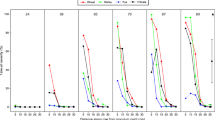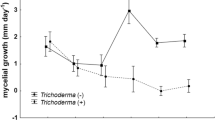Abstract
In growth cabinet experiments, the common phyllosphere yeastsSporobolomyces roseus andCryptococcus laurentii var.flavescens were sprayed as a mixture (1∶1) onto the fourth leaves of maize plants (Zea mays) two-three days prior to inoculation withColletotrichum graminicola. In four experiments the average yeast population of the treated leaves at the time of pathogen inoculation varied between 5× 104 and 8× 105 cells cm−2 leaf, whereas on the untreated leaves the yeast population varied from <103 to 104 cells cm−2 leaf. The yeasts reduced lesion density and necrosis fromC. graminicola infection by approximately 50%. Contrary to findings with other necrotrophic pathogens, conidial germination, superficial mycelial growth and appressorium formation were not affected. Instead, the reduction of infection could only be explained by a reduced number of penetrations from the normally formed appressoria, a site of interaction not previously recorded.
Samenvatting
In klimaatkastexperimenten werden maisbladeren (4e blad) twee-drie dagen voor inoculatie metColletotrichum graminicola bespoten met een mengsel (1∶1) van de algemeen voorkomende fyllosfeergistenSporobolomyces roseus enCryptococcus laurentii var.flavescens. In vier experimenten varieerde de gemiddelde gistpopulatie op de behandelde bladeren, op het moment van inoculatie met het pathogen, van 5× 104 tot 8× 105 cellen cm−2 blad, op de onbehandelde bladeren van <103 tot 104 cellen cm−2 blad. De gisten reduceerden de lesiedichtheid en het necrotisch bladoppervlak tengevolge van deC. graminicola infectie voor ongeveer 50%. De stadia in de ontwikkeling van andere necrotrofe pathogenen, die gewoonlijk gevoelig zijn voor antagonisme door gisten, zoals sporekieming, oppervlakkige myceliumgroei en vorming van appressoria, werden bijC. graminicola niet beïnvloed. De waargenomen reductie van infectie kon alleen verklaard worden door een remming van de penetratie vanuit normaal gevormde appressoria. Interactie in dit stadium van het infectieproces is nog niet eerder waargenomen.
Similar content being viewed by others
References
Bashi, E. & Fokkema, N.J., 1977. Environmental factors limiting growth ofSporobolomyces roseus, an antagonist ofCochliobolus sativus, on wheat leaves. Trans. Br. Mycol. Soc. 68: 17–25.
Blakeman, J.P. & Brodie, I.D.S., 1976. Inhibition of pathogens by epiphytic bacteria on aerial plant surfaces. In: Dickinson, C.H. & Preece, T.F. (Eds), Microbiology of aerial plant surfaces. Academic Press, London. p. 529–557.
Blakeman, J.P. & Brodie, I.D.S., 1977. Competition for nutrients between epiphytic microorganisms and germination of spores of plant pathogens on beetrot leaves. Physiol. Pl. Path. 10: 29–42.
Blakeman, J.P. & Fokkema, N.J., 1982. Potential for biological control of plant diseases on the phylloplane. A. Rev. Phytopath. 20: 167–192.
Blakeman, J.P. & Parbery, D.G., 1977. Stimulation of appressorium formation inColletotrichum acutatum by phylloplane bacteria. Physiol. Pl. Pathol. 11: 313–325.
Firman, I.D. & Waller, J.M., 1977. Coffee berry disease and otherColletrotrichum diseases of coffee. Phytopath. Pap. 20: 1–53.
Fokkema, N.J., 1981. Fungal leaf saprophytes, beneficial of detrimental? In: Blakeman, J.P. (Ed.), Microbial ecology of the phylloplane. Academic Press, London. p. 433–454.
Fokkema, N.J., 1984. Competition for endogenous and exogenous nutrients betweenSporobolomyces roseus andCochliobolus sativus. Can. J. Bot. 62: 2463–2468.
Fokkema, N.J., Houter, J.G. den, Kosterman, Y.J.C. & Nelis, A.L., 1979. Manipulation of yeasts of field-grown wheat leaves and their antagonistic effect onCochliobolus sativus andSeptoria nodorum. Trans Br. Mycol. Soc. 72: 19–29.
Fokkema, N.J. & Nooij, M.P. de, 1981. The effects of fungicides on the microbial balance in the phyllosphere. EPPO Bull. 11: 303–310.
Kolattukudy, P.E., 1984. Fungal penetration of defensive barriers of plants. In: Duggar, W.M. & Bartnicki-Garcia, S. (Eds), Structure, function and biosynthesis of plant cell walls. Proc. Seventh. Symp. Bot., Univ. Calif. Riverside p. 302–343.
Lapp, M.S. & Skoropad, W.P., 1978. Location of appressoria ofColletotrichum graminicola on natural and artificial barley leaf surfaces. Trans. Br. Mycol. Soc. 70: 225–228.
Leben, C., 1964. Influence of bacteria from healthy cucumber leaves on two leaf diseases of cucumber. Phytopathology 54: 405–408.
Leben, C., Daft, G.C., Wilson, J.D. & Winter, H.F., 1965. Field tests for disease control with an epiphytic bacterium. Phytopathology 55: 1375–1376.
Lenné, J.M. & Parbery, D.G., 1976. Phyllosphere antagonists and appressorium formation inColletotrichum gloeosporioides. Trans. Br. Mycol. Soc. 66: 334–336.
Lingappa, B.T. & Lockwood, J.L., 1963. Direct assay of soils for fungistasis. Phytopathology 53: 529–531.
Mercer, P.R., Wood, K.S. & Greenwood, A.D., 1970. The effect of orange extract and other extracts on the anthracnose of French beans byColletotrichum lindemuthianum. Ann. Bot. 34: 593–604.
Politis, D.J., & Wheeler, H., 1973. Ultrastructural study of penetration of maize leaves byColletotrichum graminicola. Physiol. Pl. Path. 3: 465–471.
Shipton, W.A. & Brown, J.F., 1962. A whole leaf clearing technique to demonstrate host-pathogen relationships of wheat stem rust. Phytopathology 52: 1313.
Sleesman, J.P. & Leben, C., 1976. Microbial antagonists ofBipolaris maydis. Phytopathology 66: 1214–1218.
Sokal, R.R. & Rohlf, F.J., 1969. Biometry. W.H. Freeman and Co., San Francisco.
Straka, R.P. & Stokes, J.L., 1957. Rapid destruction of bacteria in commonly used dilutants and its elimination. Appl. Microbiol. 5: 21–25.
Suzuki, K., Furusawa, I., Ishida, N. & Yamamoto, M., 1981. Protein synthesis during germination and appressorium formation ofColletotrichum lagenarium spores. J. Gen. Microbiol. 124: 61–69.
Suzuki, K., Furusawa, I., Ishida, N. & Yamamoto, M., 1982. Chemical dissolution of cellulose membranes as a prerequisite for penetration from appressoria ofColletotrichum lagenarium. J. Gen. Microbiol. 128: 1035–1039.
Wolkow, P.M., Sisler, H.D. & Vigil, E.L., 1983. Effects of inhibitors of melanin biosynthesis on structrue and function of appressoria ofColletotrichum lindemuthianum. Physiol. Pl. Path. 23: 55–71.
Author information
Authors and Affiliations
Rights and permissions
About this article
Cite this article
Williamson, M.A., Fokkema, N.J. Phyllosphere yeasts antagonize penetration from appressoria and subsequent infection of maize leaves by Colletotrichum graminicola. Netherlands Journal of Plant Pathology 91, 265–276 (1985). https://doi.org/10.1007/BF02000012
Accepted:
Issue Date:
DOI: https://doi.org/10.1007/BF02000012




